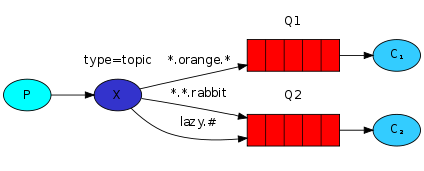上篇文章RabbitMQ基础入门学习了rabbitMQ一些基础的api,当然spring也在原生代码的基础上做了更多的封装,这篇文章就基于spring-rabbit,学习一下spring的实现。
引入jar:
<dependency>
<groupId>org.springframework.amqp</groupId>
<artifactId>spring-rabbit</artifactId>
<version>1.5.0.RELEASE</version>
</dependency>
上篇文章没有测试到Topic exchange,下面就使用Topic exchange做测试。
1.基于springframework.amqp.rabbit java写法。
1 import org.springframework.amqp.core.BindingBuilder; 2 import org.springframework.amqp.core.Queue; 3 import org.springframework.amqp.core.TopicExchange; 4 import org.springframework.amqp.rabbit.annotation.RabbitListener; 5 import org.springframework.amqp.rabbit.connection.CachingConnectionFactory; 6 import org.springframework.amqp.rabbit.core.RabbitAdmin; 7 import org.springframework.amqp.rabbit.core.RabbitTemplate; 8 import org.springframework.amqp.rabbit.listener.SimpleMessageListenerContainer; 9 import org.springframework.amqp.rabbit.listener.adapter.MessageListenerAdapter; 10 11 @RabbitListener(queues = "hello") 12 public class Tut1Java { 13 14 public static void main(final String... args) throws Exception { 15 16 CachingConnectionFactory cf = new CachingConnectionFactory(); 17 cf.setAddresses("192.168.1.7:5672"); 18 cf.setUsername("admin"); 19 cf.setPassword("admin"); 20 21 // set up the queue, exchange, binding on the broker 22 RabbitAdmin admin = new RabbitAdmin(cf); 23 Queue queue = new Queue("myQueue"); 24 admin.declareQueue(queue); 25 TopicExchange exchange = new TopicExchange("myExchange"); 26 admin.declareExchange(exchange); 27 admin.declareBinding(BindingBuilder.bind(queue).to(exchange).with("foo.*")); 28 29 // set up the listener and container 30 SimpleMessageListenerContainer container = new SimpleMessageListenerContainer(cf); 31 Object listener = new Object() { 32 // 接受到消息时,会执行此方法 33 public void handleMessage(String foo) { 34 System.out.println("Tut1Java " + foo); 35 } 36 }; 37 MessageListenerAdapter adapter = new MessageListenerAdapter(listener); 38 container.setMessageListener(adapter); 39 container.setQueueNames("myQueue"); 40 container.start(); 41 42 // send something 43 RabbitTemplate template = new RabbitTemplate(cf); 44 // 只有routingKey符合foo.*规则的才会被接受处理 45 template.convertAndSend("myExchange", "foo.bar", "Hello, world!"); 46 container.stop(); 47 } 48 }
整块代码可以简单的实现了发送接收消息,主要分为四个部分。
16~19行 初始化一个CachingConnectionFactory,其实底层也是原生的ConnectionFactory。
22~27行 主要是设置queue和exchange,并把它们按照"foo.*"的路由规则绑定起来。
new Queue("myQueue"),创建一个本地持久话名字叫myQueue的队列。
declareQueue(queue),声明一个队列。
new TopicExchange("myExchange"),创建一个topic exchange,看名字也知道exchange类型是topic,我们只要传递参数就好了。当然也会有FanoutExchange、DirectExchange、HeadersExchange。
BindingBuilder.bind(queue).to(exchange).with("foo.*"),将queue绑定到exchange上,并以"foo.*"作为他们之间的路由规则。
30~40行 主要是通过SimpleMessageListenerContainer去监听消息,并且可以设置特定类的方法去执行处理接受到的消息。
Object listener = new Object() { // 接受到消息时,会执行此方法 public void handleMessage(String foo) { System.out.println("Tut1Java " + foo ); } public void handleMessage2(String foo) { System.out.println("Tut1Java2 " + foo); } }; MessageListenerAdapter adapter = new MessageListenerAdapter(listener); adapter.setDefaultListenerMethod("handleMessage2"); container.setMessageListener(adapter);
如果消息监听写成上面这样,那么将执行handleMessage2(String foo) 。
43~46行 利用RabbitTemplate发送消息,三个参数依次为exchange、routingKey和发送的消息,
首先exchange名称要和admin声明的一致,routingKey要符合当前topic exchange的路由规则,否则消息不会发送到当前队列中。
再看一下topic exchange的模型:

最后运行一下,可以发现消息被顺利打印出来了。
2.基于spring配置写法
<?xml version="1.0" encoding="UTF-8"?> <beans xmlns="http://www.springframework.org/schema/beans" xmlns:xsi="http://www.w3.org/2001/XMLSchema-instance" xmlns:mvc="http://www.springframework.org/schema/mvc" xmlns:context="http://www.springframework.org/schema/context" xmlns:aop="http://www.springframework.org/schema/aop" xmlns:rabbit="http://www.springframework.org/schema/rabbit" xsi:schemaLocation="http://www.springframework.org/schema/beans http://www.springframework.org/schema/beans/spring-beans.xsd http://www.springframework.org/schema/context http://www.springframework.org/schema/context/spring-context.xsd http://www.springframework.org/schema/rabbit http://www.springframework.org/schema/rabbit/spring-rabbit-1.0.xsd http://www.springframework.org/schema/mvc http://www.springframework.org/schema/mvc/spring-mvc.xsd http://www.springframework.org/schema/aop http://www.springframework.org/schema/aop/spring-aop-3.1.xsd"> <rabbit:connection-factory id="connectionFactory" username="admin" password="admin" host="192.168.1.7" port="5672" virtual-host="/" /> <rabbit:template id="amqpTemplate" connection-factory="connectionFactory" exchange="myExchange" routing-key="foo.bar"/> <rabbit:admin connection-factory="connectionFactory" /> <rabbit:queue name="myQueue" /> <rabbit:topic-exchange name="myExchange"> <rabbit:bindings> <rabbit:binding queue="myQueue" pattern="foo.*" /> </rabbit:bindings> </rabbit:topic-exchange> <rabbit:listener-container connection-factory="connectionFactory"> <rabbit:listener ref="foo" method="listen" queue-names="myQueue" /> </rabbit:listener-container> <bean id="foo" class="rabbitMQ.springAMQP.Foo" /> </beans>
在context.xml中可以看到很多熟悉的rabbitMQ的对象,这种写法只不过从上面new出来的对象,改为使用spring的xml去声明各种bean对象。
import org.springframework.amqp.rabbit.core.RabbitTemplate; import org.springframework.context.support.AbstractApplicationContext; import org.springframework.context.support.ClassPathXmlApplicationContext; public class Tut1Spring { public static void main(final String... args) throws Exception { AbstractApplicationContext ctx = new ClassPathXmlApplicationContext("spring/context.xml"); RabbitTemplate template = ctx.getBean(RabbitTemplate.class); template.convertAndSend("Tut1Spring " + "Hello, world!"); Thread.sleep(1000); ctx.destroy(); } }
public class Foo { public void listen(String foo) { System.out.println("Foo=" + foo); } }
Foo为处理接受并处理消息的类,在xml中也指定了执行的方法为listen。
最后运行一下,可以发现消息被顺利打印出来了。
其实无论是哪种方式的实现,内部本质还是基于最原生的api,我们只要理解最基础的部分,这些理解起来还是比较容易的。